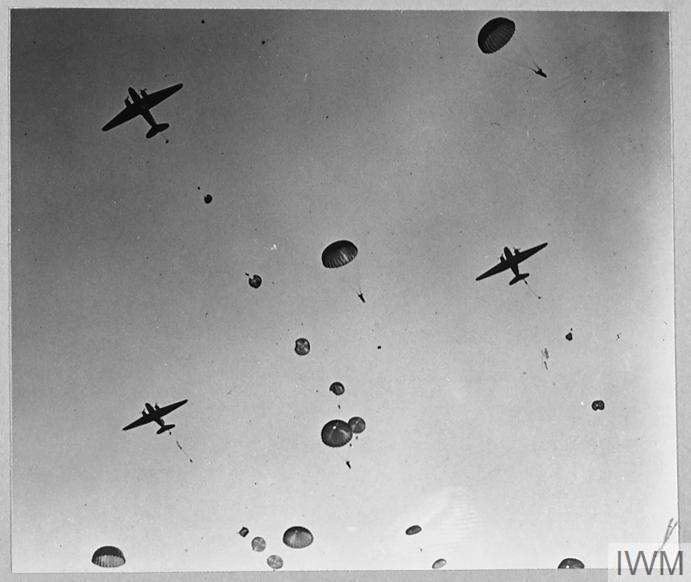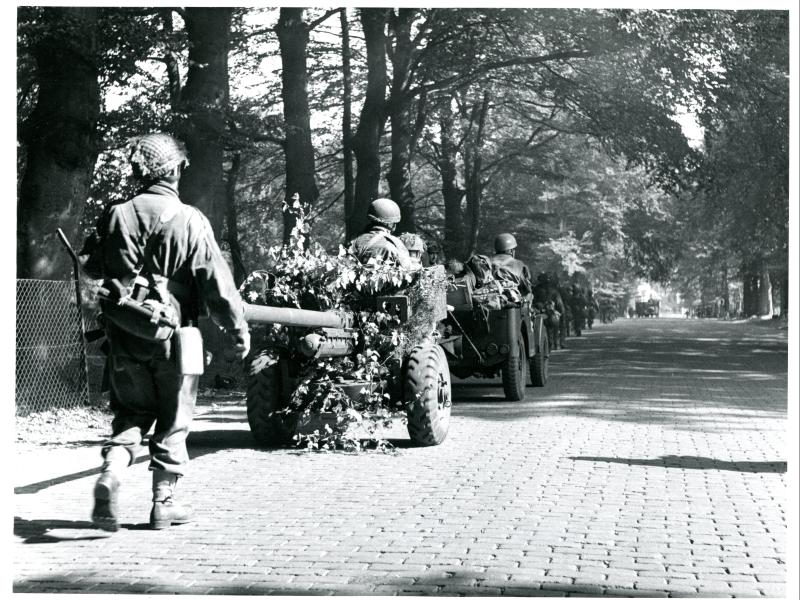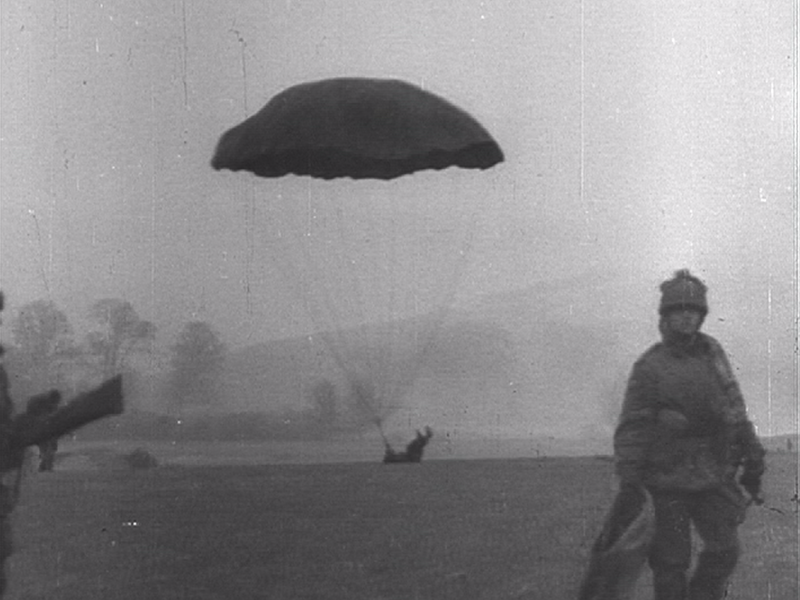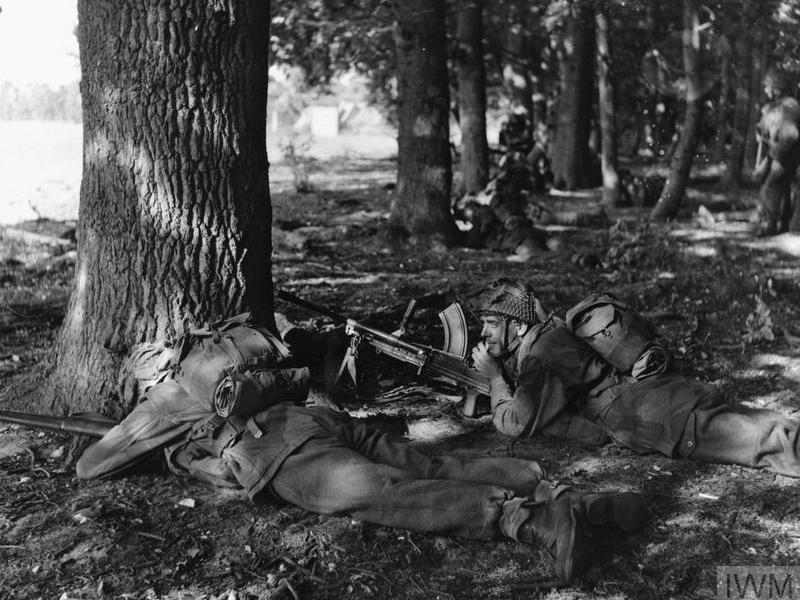Exercise TONY, 11/12 April 1944
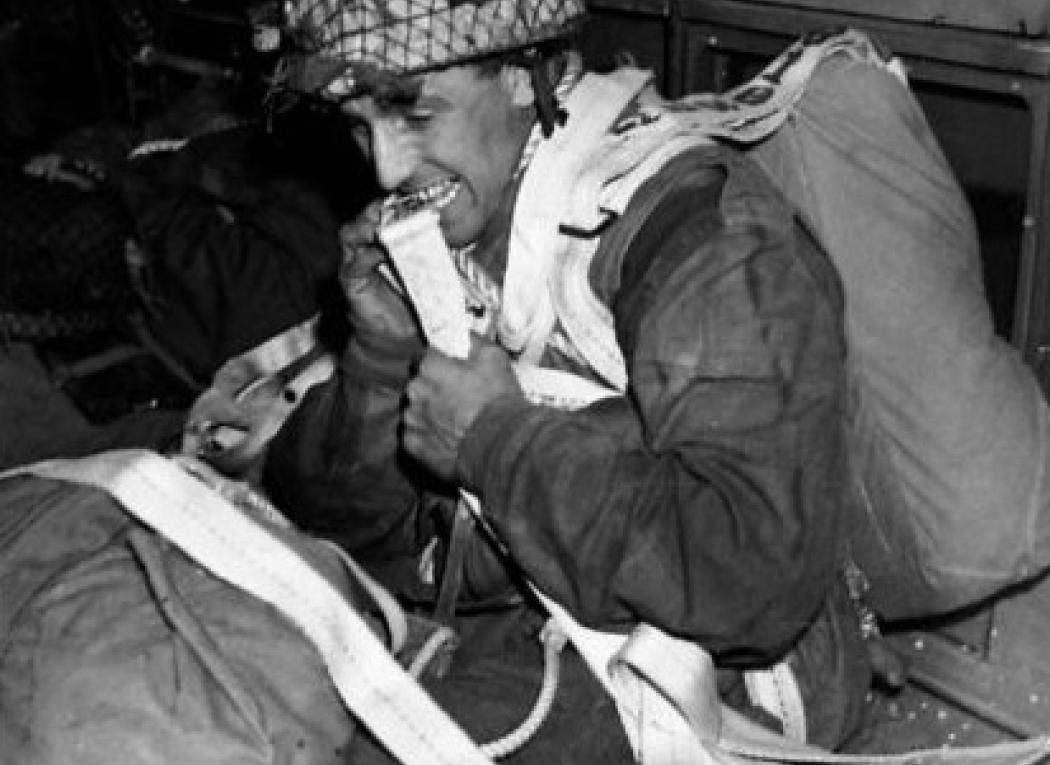
Note:
The War Office base map used in this document is Sheet 55 (Grantham) of the England and Wales One-Inch Popular Series, GSGS 3907 - 1933-43, and is reproduced with the permission of the National Library of Scotland. It can be accessed online here: Map Sheet 55 Grantham of the wartime military Ordnance Survey series
Overview
Exercise TONY was planned to take place on the night of 11/12 April 1944 and would involve troops of the 1st Parachute Brigade, to which the 21st Independent Parachute Company (Pathfinders) and a Parachute Platoon of the Royal Army Service Corps would be attached. For the exercise, this combined grouping was to be known as the 1st Parachute Brigade Group.
The exercise was aimed at practising the following specific tactical procedures:
- Reorganization after a night parachute drop onto one dropzone (DZ).
- Protection of rendezvous (RV) points on the DZ.
- Protection during the move to an objective.
No background scenario would be need: it was to be just assumed that 1st Parachute Brigade had been ordered to land behind enemy lines to seize an important feature.
Participants
The following units were to take part in the exercise:
- HQ 1st Parachute Brigade
- Brigade Defence Platoon
- Brigade Signals Section
- 1st Parachute Battalion
- 2nd Parachute Battalion
- 3rd Parachute Battalion
- 1st Parachute Squadron Royal Engineers (RE)
- 16th (Parachute) Field Ambulance, Royal Army Medical Corps (RAMC)
- Detachment of the 21st Independent Parachute Company (Pathfinders)
- Parachute Platoon of the Royal Army Service Corps (RASC)
To test the actions of these units, an enemy force would be formed by drawing small numbers of troops from each of the participating parachute battalions. They would wear berets to distinguish them from ‘friendly’ troops, who would wear steel helmets. The enemy troops would not jump but would be ferried around as necessary by unit motor transport. Their role was to engage friendly forces as they re-formed at RV points on the dropzone and as they made their way to their objectives.
The Flight
The paratroops would fly to the DZ in C-47 aircraft of the US 313th and 314th Troop Carrier Groups (TCG), based at Folkingham and Saltby airfields respectively. The parachute drop would take place on Ropsley Heath, to the east of Grantham, and each TCG would plan its own circuitous flight route from its airfield to the DZ.

The flight route planned by the 314th Troop Carrier Group from Saltby airfield to the dropzone at Ropsley Heath, 11/12 April 1944.
'Pundits' and 'occults' were identification beacons that flashed a unique combination of letters in Morse code to aid aerial navigation at night and in bad weather.
(Clayton Stiles Collection, American Heritage Center, University of Wyoming; courtesy of Col Mark Vlahos USAF Retd)
The Parachute Drop
For the exercise, the DZ was to be divided into two centrelines 600 yards apart, each marked by red or green lights laid out on the DZ by the Pathfinders of the 21st Independent Parachute Company. The Pathfinders would also set up a Eureka beacon midway between the centrelines, and this would respond to signals transmitted from the lead aircraft of the formations to aid their navigation to the DZ.
The centrelines were allocated individually to units of the Brigade Group, and the C-47s would fly in from the west and drop the troops as close as possible to the relevant marker lights.
The Pathfinders were scheduled to drop at 0100 hrs on 12 April 1944, allowing one hour for them to set up the markers before the main body of troops dropped at 0200-0208 hrs. The plan then allowed a little over an hour for the troops to form up at their RV points on Ropsley Heath before setting off for their objectives at 0315 hrs.
The Objectives
The objectives were civilian villages and were not involved in any tactical exercise play:
- 1st Parachute Brigade HQ Group: SAPPERTON
- 1st Parachute Battalion Group: HEYDOUR
- 2nd Parachute Battalion: BOOTHBY PAGNELL
- 3rd Parachute Battalion Group: INGOLDSBY
The exercise would finish when the troops arrived at their objectives, and they would return to their home locations by motor transport.
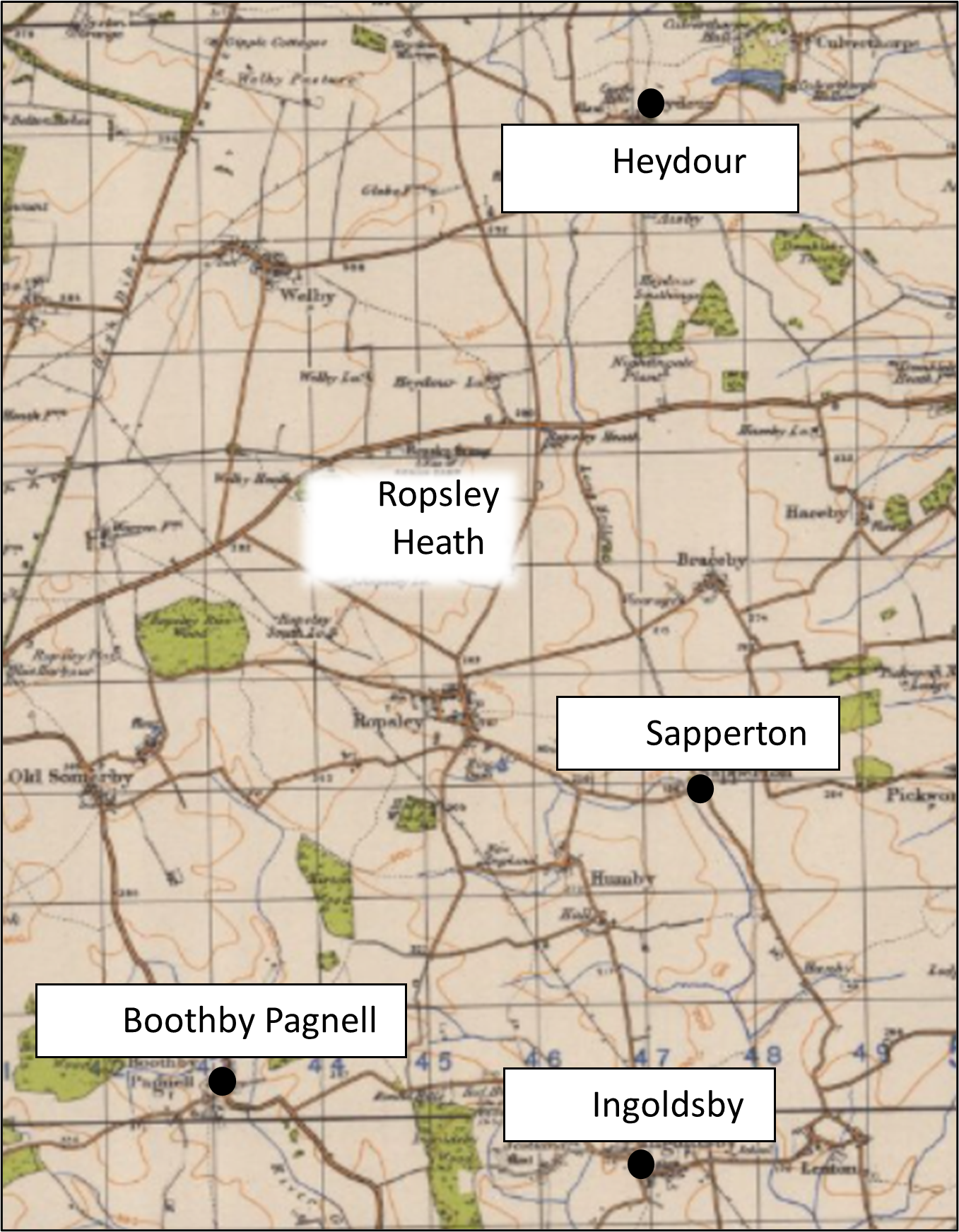
Map showing the area of operations for Exercise TONY.
WHAT ACTUALLY HAPPENED
Unfortunately, the exercise did not run according to plan. The start was delayed when the troop-carrier aircraft at Folkingham and Saltby could not take off because ten German aircraft had crossed the coast at Cromer just after midnight on 11/12 April 1944. They roamed over Norfolk, The Wash and Lincolnshire for the next hour, shooting down three British and one American aircraft.
When the C-47s of the 313th TCG and 314th TCG eventually took off, they flew circuitous routes to the DZ from their home airfields. The route planned by the 314th TCG took just over two hours and involved flying from Saltby airfield to Waddington (near Lincoln), Riccall (near York) and Nottingham, before flying direct to Ropsley Heath.
Unfortunately, many of the aircrew were unable to locate the DZ and there was confusion over the DZ caused by aircraft and gliders not related to the exercise appearing in the area at the same time. As a result, many men of the 1st Parachute Brigade Group returned with their aircraft to the departure airfields or were dropped too far from the DZ to participate in the exercise. Those men who did drop successfully onto Ropsley Heath continued with the exercise as planned.
AFTER THE EXERCISE
WAR DIARIES
The reports in the War Diaries of the 1st, 2nd and 3rd Parachute Battalions range from brief mentions to detailed summaries. Although the 1st Battalion was satisfied with its drop, many men of the 2nd Battalion were still missing by the time it moved off the DZ at 0345 hrs. The entry for the 3rd Battalion provides little information on its participation.
1st Parachute Battalion War Diary2
12 April 1944 Take off was 0030. Drop 0230. The drop was a good one. 0700hrs, Ex Tony ends. 0800 Bn Embus. 0910 Bn arrives back at billets. Checking of equipment etc. Bn rests.
2nd Parachute Battalion War Diary3
12 April 1944, 0045 hrs Aircraft take off
12 April 1944, 0250 hrs Bn drop on DZ at Ropsley Heath 4455 [grid reference] Sheet 55, the DZ being divided by two centre lines. Centre Line ‘A’ from SE corner of Abney Wood 442555 [grid reference] to 460560 [grid reference]. Centre Line ‘B’ from 445550 [grid reference] to 460555 [grid reference] all MRs [map references] from Sheet 55.
The take off was put forward 45 minutes owing to an enemy air raid being in progress.
The whole of ‘A’ and ‘S’ Coy with the exception of one stick did not drop, owing to the formation being split up and enemy aircraft in the vicinity.
The descent was not a success, personnel being dropped in a wide area. After drop, Bn RV’d [rendezvoused] at Ropsley Lodge 4454.
12 April 1944, 0330 hrs All Coys in position in area 4454, Bde and Bn sets in communication. Only 50% Bn strength reported.
12 April 1944, 0345 hrs Bn move off by route of march, order of march B Coy, Bn HQ, C Coy, route taken: Ropsley Lodge – 443548 along track to Ropsley South Lodge – across country road 441542 – across country to road 448533 – along track passing Kirton Wood and Boothby Little Wood – to point 279 in area Boothby Pagnell 4250.
[See map below for the route taken by elements of the 2nd Parachute Battalion from the DZ to Boothby Pagnell.]
12 April 1944, 0700 hrs Bn embus on TCVs [Troop-Carrying Vehicles] and leave for respective billets.
3rd Parachute Battalion War Diary4
11 April 1944 Exercise TONY area ROPSLEY HEATH Sh 55 [map sheet].
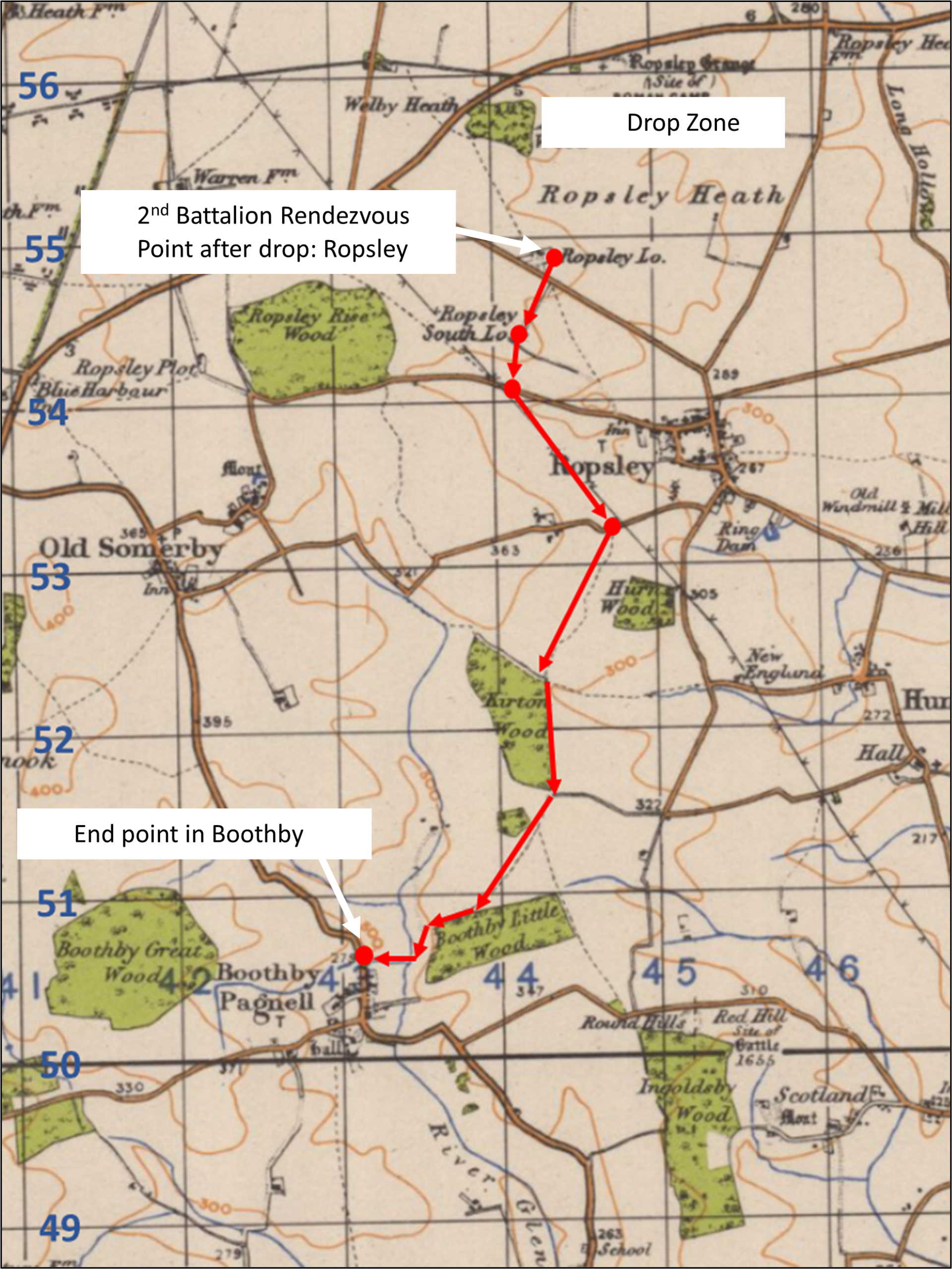
2nd Parachute Battalion march route, 12 April 1944.
OFFICIAL REPORTS
Report on Exercise TONY by the Commanding Officer, 1st Parachute Brigade
The commander of the 1st Parachute Brigade, Brigadier Gerald Lathbury, submitted a post-exercise report, which was included as Appendix F to the HQ 1st Parachute Brigade War Diary for April 1944. Referring to the drop on Ropsley Heath, he stated that the leading half of the 313th TCG dropped well and accurately but the remainder failed to drop at all. Of the 314th TCG, he stated that it ‘…dropped late and at all angles, heights, speeds and times.’ He produced statistics to show that just under 50% of the troops failed to drop or dropped inaccurately, with 15 of the 48 aircraft of the 314th TCG dropping troops over one mile from the DZ, including one aircraft that dropped its troops near Nottingham. Lathbury’s report makes no mention of any unexpected aircraft or gliders in the vicinity of the DZ at the time of the drop.
Lathbury pointed out that the marker lights displayed by the Pathfinders were ‘useless’ because they were not bright enough to be seen from the air at a sufficient distance to enable the aircraft to readjust their course.
In his conclusion, Lathbury was scathing about the performance of the troop-carrier aircrew:
The results of the drop were most disappointing. Conditions were excellent and unless the standard of training of the pilots is substantially improved, I see no hope of a successful night drop under active service conditions.
In my view, the present method of formation dropping on a beacon promotes a lack of initiative on the part of all but the leading pilots. There were many cases of pilots who said, afterwards, that they saw the DZ but did not drop as they received no signal from the leading aircraft.
I think it is wrong to depend entirely on a homing device [Eureka beacon] which may so easily fail. Navigators should still be able to bring in their aircraft by the map by day or in bright moonlight, and the lights marking the DZ should be far brighter.
Although it is outside my province to make suggestions as regards the training of American Air Force personnel, I consider that they should have more practice in dropping dummies or containers. As far as possible, every practice flight should finish with the dropping of dummies on a prearranged DZ and the results checked.5
Lathbury closed by saying that he had seen no improvement in the troop-carrier performance since the rehearsal exercises that had been carried out before the invasion of Sicily nearly one year previously, and he requested that the substance of his report be conveyed to the Commanding Generals of the US IX Troop Carrier Command and the 52nd Troop Carrier Wing, to which the 313rd and 314th TCGs were subordinated.
Report on Exercise TONY by the US 52nd Troop Carrier Wing
The 313th TCG and 314th TCG came under the command of the 52nd Troop Carrier Wing, whose diary entry for the exercise provided a different view from that of Brigadier Lathbury:
The second practice paratroop mission, TONY, was flown on the morning of 12 April 1944, 96 aircraft of the 313th and 314th Troop Carrier Groups participating. Take off was at 0015 hours and the prescribed course was flown up to the initial point. On the final run from the IP [Initial Point] to DZ numerous aircraft (not our own), some with gliders in tow, were encountered flying at the same altitude as our Group formations. The 314th made a normal approach to the DZ and dropped its troops in good order at 0227 hours. However, the 313th Group, because of the above mentioned aircraft and gliders, had to change its course and altitude on the final run. The Group formation thus broken up the five squadrons had to make individual approaches and drops. Fourteen aircraft returned without dropping their troops because of the unexpected traffic and confusion at the DZ. The troops dropped by the two Groups were well concentrated near the Tee [aiming point marked by lights].6
Although the entry states that the 314th TCG ‘…made a normal approach to the DZ and dropped its troops in good order…’, the Group was restricted to base for a week to practise day and night formation flying. Towards the end of the week, 45 aircraft of the 314th TCG flew a low-level formation across country, including ‘buzzing’ the 52nd TCW Headquarters airfield at Cottesmore. This action resulted in the 314th TCG being restricted to base for a further week with more training flights.7
FINALLY, ONE HISTORIAN'S VIEW...
In his book, Arnhem 1944, the late historian, Dr William Buckingham, summarised the training value of Exercise TONY:
This was the only Brigade jump performed by 1st Parachute Brigade before Arnhem, although poor aircrew skills reduced the value of the exercise considerably. Despite perfect conditions, the drop was widely scattered and some aircraft returned with the paratroopers on board because they were unable to locate the drop zone. As far as 1st Parachute Brigade was concerned, the performance of the US aircrew showed no improvement since the fiasco at the Ponte Primasole the previous July. Lathbury made his feelings known in no uncertain terms to the US 52nd Troop Carrier Wing and its superior, US 9th Troop Carrier Command. The only other parachute training undertaken by the Brigade was a small-scale drop for a signals exercise on 1 June 1944, which involved five aircraft.8
- 5
National Archives, WO 171/592.
- 6
Microfilm reel number B0984, Air Force Historical Research Agency, Maxwell Air Force Base, Alabama.
- 7
Vlahos, M., 2021. Men Will Come. Revised 2nd Edition. Hoosick Falls NY 12090: Merriam Press, p.159-161.
- 8
Buckingham, W. F., 2004. Arnhem 1944, p 38. Stroud: Tempus Publishing Limited.
ACKNOWLEDGEMENTS
Richard Chancellor, Aviation historian and USAAF research specialist.
Mark Hickman, Creator of the website, The Pegasus Archive, British Airborne Forces 1940-1945. Website: https://www.pegasusarchive.org/
Colonel Mark Vlahos, USAF Retired, Historian and author of Men Will Come, A History of the 314th Troop Carrier Group, 1942-1945. Website: https://markcvlahos.com/
